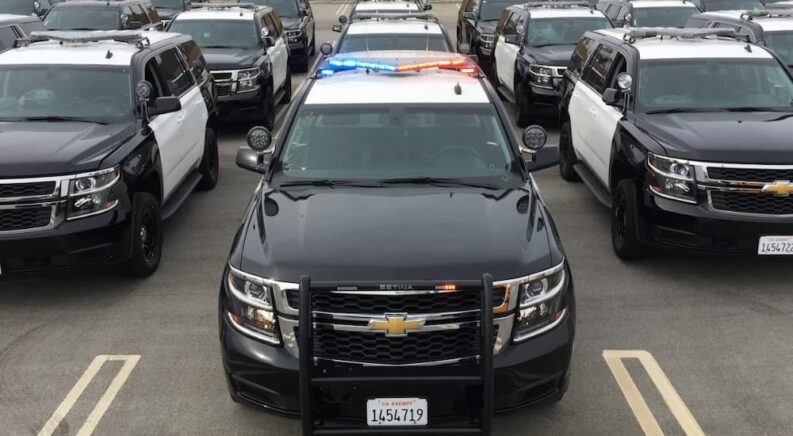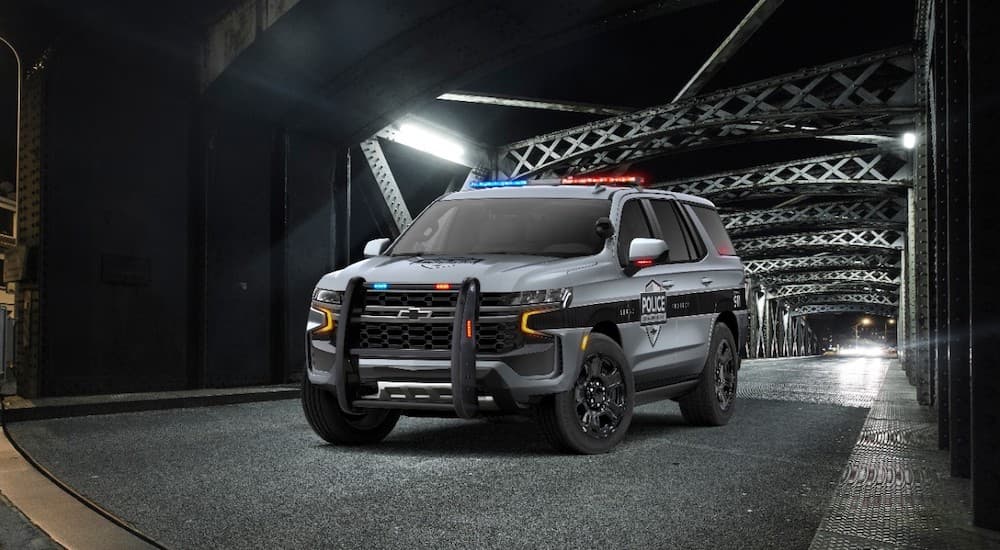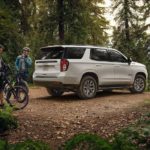When lives hang in the balance, only the best will do. From local and state police to sheriff’s departments and more, law enforcement agencies have long turned to Chevy for many of their automotive needs. Chevy isn’t the only automaker to develop such a close relationship with these groups, but its collaboration has produced some of the most recognizable police pursuit vehicles on the road. One of the most recent examples is the Chevy Tahoe Police Pursuit Vehicle (PPV).
Those in the market for a used Chevy Tahoe for sale aren’t very likely to run across anything quite like the Tahoe PPV, which sees Chevy’s full-size SUV outfitted with a host of heavy-duty upgrades, including rocker covers, new brakes, upgraded engine and transmission coolers, pursuit-rated tires an overhauled suspension and more. It’s a thorough makeover and one that transforms the already-capable Tahoe into a lean, mean law-enforcing machine. Let’s take a closer look under the hood, examine the automaker’s long-standing relationship with law enforcement, and see how Chevy is helping to make America safer, one PPV at a time.
Chevy Goes on Duty
Chevy has offered a PPV version of the Tahoe since 1997, but the automaker’s ties to law enforcement stretch back much further than that. Chevy’s first offering came as the 1959 Chevy Biscayne, a limited version of the brand’s popular sedan that saw a specially tuned 348-cu.in. V8 under the hood. Capable of producing a blistering top speed of 135 mph, the Biscayne allowed police to keep up with some of the increasingly powerful models of the era. Chevy would upgrade the Biscayne and Bel Air throughout the ’60s, offering a big-block 396-cu.in. (and later 427-cu.in.) V8 that would make these models the most powerful patrol cars of their era.
Chevy’s experiments with the Biscayne and Bel Air would become formalized in the 1970s as the company introduced the 9C1 production code for law enforcement vehicles. The package was first offered on the 1975 Chevy Nova, with the Los Angeles County Sheriff’s Department testing the prototype in 1974. Five years later, Chevy would expand the designation to the Malibu 9C1, which earned some notoriety for its surprisingly high 13th-place finish at the 1979 Cannonball Run from New York to Los Angeles, but it was the Chevy Impala 9C1 that would cement the relationship between the automaker and law enforcement. A mainstay of law enforcement agencies nationwide, the Impala 9C1 would also get its fair share of screentime with roles in some of the most beloved movies and TV shows of its era.
The Impala 9C1 would be the trusty sidekick of countless officers until 1986, when the sedan was replaced by the Caprice 9C1. Available in both V6 and V8 formats, the Caprice 9C1’s preferred engine was the 5.7-liter small-block V8, producing 205 hp and 300 lb-ft of torque. That said, it was the Caprice’s innovative body-on-fame construction that made it such a hit with police. Its heavy-duty construct method—which is typically reserved for pickup trucks and full-size SUVs—made the Caprice one of the most rugged sedans on the road: perfect for the kind of takedown maneuvers required of a police pursuit vehicle.
Chevy would continue to tweak the sedan in response to law enforcement feedback, but it was the addition of the Chevy LT1 V8 in 1994 that would mark the most significant improvement to date. With 260 hp to its name, the LT1 instantly made the Caprice one of the most powerful police vehicles ever produced. Chevy would sunset the Caprice in 1996, but it wasn’t easy to replace since few models could match its unique combination of fuel economy, horsepower, affordability, and reliability. The Caprice would continue to serve law enforcement agencies for years to come due to the lack of a worthy replacement… until the return of the Impala.
Going on duty in 2000, the Impala 9C1 wasn’t quite as powerful as the outgoing Caprice—with a 3.8-liter V6 producing 200 hp and 200 lb-ft of torque—but it made up for it in plenty of other ways. Like previous Chevy PPVs, the Impala featured auxiliary coolers for the engine and transmission but added a power steering cooler for good measure. Those features—paired with a heavy-duty radiator, front struts, shock absorbers, and brakes—made the standard-issue Impala a police-worthy ride.
This sedan also included a few features geared toward the unique demands of the job. For instance, a 125-amp alternator gave the Impala better battery life when cruising at low speeds while allowing it to power all the accessories and gadgets found in the average cruiser. Stab-proof seatbacks, lockout protection, and a Surveillance Mode that allowed officers to disable all interior lights rounded out the Impala’s arsenal and made it a favorite of large inner-city police departments like the NYPD. The ninth-generation Impala 9C1 would continue to perfect this formula, adding electronic stability control and a 300-hp 3.6-liter V6 engine that gave the sedan a dramatically improved zero-to-sixty time of 7.2 seconds.
In Pursuit of a Better PPV
That brings us to the star of the show: the Tahoe 9C1. Chevy’s full-size SUV first got the PPV treatment in 1997 when the bowtie brand began offering the Z56 police package that saw the Tahoe outfitted with suspension components from the Chevy 454 SS sport pickup. The Tahoe is the perfect replacement for the outgoing Caprice and Impala models, which were being phased out as Chevy ceased production of its body-on-frame passenger sedan due to the growing popularity of SUVs. Offered in both two- and four-wheel drive versions, the Tahoe can be suited for different applications.
High-speed pursuit and city driving are the specialties of the 2WD PPV model thanks to its lower center of gravity, while the 4WD Tahoe—often designated as the Special Service Vehicle (SSV)—is the preferred choice of law enforcement agencies that regularly have to contend with snow, ice, trails, and other challenging conditions. The Tahoe has won over plenty of officers since going into service and holds the distinction of being the only body-on-frame, rear-wheel drive, pursuit-rated police vehicle manufactured for the US market.
2021 saw the introduction of an all-new Tahoe PPV, which might just be the best version yet. There’s no mistaking this version of the Tahoe PPV from your standard, civilian-issue SUV; it includes all the features one would expect for a performance-minded pursuit vehicle, including 20-inch wheels wrapped in Firehawk Pursuit tires (developed in partnership with Bridgestone), Brembo brakes with six pistons and 16-inch rotors, and a fortified suspension and rocker covers borrowed from the Corvette and Camaro.
Designed to improve ventilation in the crankcase, these rocker covers allow the Tahoe to withstand higher lateral loads than ever before. A 5.3-liter V8 powers the whole rig, giving law enforcement access to 355 hp and 383 lb-ft of torque every time they step on the gas. Since the taxpayer is fitting the gas bill, it’s also nice to see the inclusion of GM’s Dynamic Fuel Management system, which uses 18 different firing patterns to provide the best possible fuel efficiency.
The Tahoe also carries over some of the best features of previous PPV models, including an engine and transmission cooler and a fortified suspension. These features allow the Tahoe to withstand the high speeds and sudden stops that go hand-in-hand with many police pursuits—a vital design for any law enforcement vehicle.
“We do that because the needs of the police officer for this vehicle are different than the needs of the general consumer; they need to be able to do high-speed pursuits,” says Erick Stanczak, chief engineer for Chevrolet. “The controls have to match that hardware, so we have a special set of tuning we put on the chassis control system to make sure the vehicle handles well and is predictable at high speeds.”
The Tahoe’s suspension is specially tuned with dampers and springs that have been calibrated with specific spring rates and loads, allowing the PPV to reach speeds up to 134 mph with minimal disruption to ride quality and safety. Like previous PPV models, the Tahoe features a high-output alternator and 760-amp auxiliary battery that gives officers all the juice they need to operate their siren, radio and computer system. This SUV also ships with 31 wire circuits throughout the cockpit and 56 in the cargo area, allowing law enforcement agencies to throw in whatever gizmos and gadgets they see fit—but that’s not the only tech-minded trick it has up its sleeve.
The Tahoe PPV also comes standard with 4G LTE Wi-Fi, which is a vital addition considering law enforcement vehicles often double as mobile offices. Comfort and cargo space are also paramount, with Chevy achieving a best-in-class 70.3-cu.ft. behind the second-row seats. The doors are also 3.5 inches larger than previous Tahoe models, which can come in handy when loading an uncooperative suspect into the backseat. Lastly, there are little touches that go far in improving overall practicality, like wide front seats designed to accommodate an officer’s utility belt.
More on the Horizon
The Tahoe PPV represents the culmination of more than sixty years of PPV design, making it an invaluable tool for enforcing law and order. That said, Chevy doesn’t look like it’s going to stop tinkering any time soon. In early 2023, the automaker released a 9C1 version of the Chevy Blazer EV, whose all-electric platform brings some obvious benefits to efficiency, but it’s also a major upgrade in terms of power thanks to its electric motor that’s capable of churning out 498 hp and 531 lb-ft of torque. Those numbers give the Blazer EV PPV the sort of lightning-fast acceleration that’s sure to come in handy in any pursuit and makes a strong case for electrification across law enforcement fleets.
No matter what the future of police pursuit models looks like, you can bet that Chevy will be right at the forefront. This legacy automaker has carved out a real niche, partnering with all levels of law enforcement to craft the perfect tool for the job. The Tahoe PPV might be the most recent example of this fruitful collaboration, but it sure won’t be the last.






